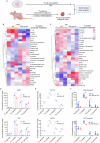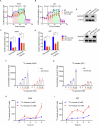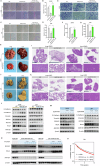AKR1B1-dependent fructose metabolism enhances malignancy of cancer cells
- PMID: 39406918
- PMCID: PMC11618507
- DOI: 10.1038/s41418-024-01393-4
AKR1B1-dependent fructose metabolism enhances malignancy of cancer cells
Abstract
Fructose metabolism has emerged as a significant contributor to cancer cell proliferation, yet the underlying mechanisms and sources of fructose for cancer cells remain incompletely understood. In this study, we demonstrate that cancer cells can convert glucose into fructose through a process called the AKR1B1-mediated polyol pathway. Inhibiting the endogenous production of fructose through AKR1B1 deletion dramatically suppressed glycolysis, resulting in reduced cancer cell migration, inhibited growth, and the induction of apoptosis and cell cycle arrest. Conversely, the acceleration of endogenous fructose through AKR1B1 overexpression has been shown to significantly enhance cancer cell proliferation and migration with increased S cell cycle progression. Our findings highlight the crucial role of endogenous fructose in cancer cell malignancy and support the need for further investigation into AKR1B1 as a potential cancer therapeutic target.
© 2024. The Author(s).
Conflict of interest statement
Competing interests: The authors declare no competing interests.
Figures







Similar articles
-
β2-AR regulates the expression of AKR1B1 in human pancreatic cancer cells and promotes their proliferation via the ERK1/2 pathway.Mol Biol Rep. 2018 Dec;45(6):1863-1871. doi: 10.1007/s11033-018-4332-3. Epub 2018 Oct 10. Mol Biol Rep. 2018. PMID: 30306507
-
Fructose Metabolism in Cancer.Cells. 2020 Dec 8;9(12):2635. doi: 10.3390/cells9122635. Cells. 2020. PMID: 33302403 Free PMC article. Review.
-
SMARCA5 reprograms AKR1B1-mediated fructose metabolism to control leukemogenesis.Dev Cell. 2024 Aug 5;59(15):1954-1971.e7. doi: 10.1016/j.devcel.2024.04.023. Epub 2024 May 21. Dev Cell. 2024. PMID: 38776924
-
Evaluation of an aldo-keto reductase gene signature with prognostic significance in colon cancer via activation of epithelial to mesenchymal transition and the p70S6K pathway.Carcinogenesis. 2020 Sep 24;41(9):1219-1228. doi: 10.1093/carcin/bgaa072. Carcinogenesis. 2020. PMID: 32628753
-
Role of aldo-keto reductase family 1 member B1 (AKR1B1) in the cancer process and its therapeutic potential.J Cell Mol Med. 2020 Aug;24(16):8890-8902. doi: 10.1111/jcmm.15581. Epub 2020 Jul 6. J Cell Mol Med. 2020. PMID: 32633024 Free PMC article. Review.
Cited by
-
Exploration and validation of a novel reactive oxygen species-related signature for predicting the prognosis and chemotherapy response of patients with bladder cancer.Front Immunol. 2024 Dec 19;15:1493528. doi: 10.3389/fimmu.2024.1493528. eCollection 2024. Front Immunol. 2024. PMID: 39749345 Free PMC article.
-
Aucubin mitigates the elevation of microglial aerobic glycolysis and inflammation in diabetic neuropathic pain via aldose reductase.World J Diabetes. 2025 May 15;16(5):103915. doi: 10.4239/wjd.v16.i5.103915. World J Diabetes. 2025. PMID: 40487600 Free PMC article.
-
New hope for the world cancer day.Biol Direct. 2025 Feb 4;20(1):14. doi: 10.1186/s13062-025-00608-z. Biol Direct. 2025. PMID: 39901154 Free PMC article. No abstract available.
-
Fructose metabolism and its roles in metabolic diseases, inflammatory diseases, and cancer.Mol Biomed. 2025 Jun 23;6(1):43. doi: 10.1186/s43556-025-00287-2. Mol Biomed. 2025. PMID: 40549205 Free PMC article. Review.
-
Targeting AKR1B1 inhibits metabolic reprogramming to reverse systemic therapy resistance in hepatocellular carcinoma.Signal Transduct Target Ther. 2025 Aug 1;10(1):244. doi: 10.1038/s41392-025-02321-9. Signal Transduct Target Ther. 2025. PMID: 40750772 Free PMC article.
References
MeSH terms
Substances
LinkOut - more resources
Full Text Sources
Research Materials

